#UC of Japan
Explore tagged Tumblr posts
Text
Former Japanese Prime Minister Shinzo Abe, who was assassinated in July 2022. Inset: Unification Church founder Sun Myung Moon and his wife, Hak Ja Han Moon, in 1984.
SEPTEMBER 18, 2023
On the last morning of his life, Shinzo Abe arrived in the Japanese city of Nara, famous for its ancient pagodas and sacred deer. His destination was more prosaic: a broad urban intersection across from the city’s main train station, where he would be giving a speech to endorse a lawmaker running for reelection to the National Diet, Japan’s parliament. Abe had retired two years earlier, but because he was Japan’s longest-serving prime minister, his name carried enormous weight. The date was July 8, 2022.
In photos taken from the crowd, Abe—instantly recognizable by his wavy, swept-back hair; charcoal eyebrows; and folksy grin—can be seen stepping onto a makeshift podium at about 11:30 a.m., one hand clutching a microphone. A claque of supporters surrounds him. No one in the photos seems to notice the youngish-looking man about 20 feet behind Abe, dressed in a gray polo shirt and cargo pants, a black strap across his shoulder. Unlike everyone else, the man is not clapping.
Abe started to speak. Moments later, his remarks were interrupted by two loud reports, followed by a burst of white smoke. He collapsed to the ground. His security guards ran toward the man in the gray polo shirt, who held a homemade gun—two 16-inch metal pipes strapped together with black duct tape. The man made no effort to flee. The guards tackled him, sending his gun skittering across the pavement. Abe, shot in the neck, would be dead within hours.
At a Nara police station, the suspect—a 41-year-old named Tetsuya Yamagami—admitted to the shooting barely 30 minutes after pulling the trigger. He then offered a motive that sounded too outlandish to be true: He saw Abe as an ally of the Unification Church, a group better known as the Moonies—the cult founded in the 1950s by the Korean evangelist Reverend Sun Myung Moon. Yamagami said his life had been ruined when his mother gave the church all of the family’s money, leaving him and his siblings so poor that they often didn’t have enough to eat. His brother had committed suicide, and he himself had tried to.
“My prime target was the Unification Church’s top official, Hak Ja Han, not Abe,” he told the police, according to an account published in January in a newspaper called The Asahi Shimbun. He could not get to Han—Moon’s widow—so he shot Abe, who was “deeply connected” to the church, Yamagami said, just as Abe’s grandfather, also a prime minister and renowned political figure in Japan, had been.
Investigators looked into Yamagami’s wild-sounding claims and found, to their alarm, that they were true. After a quick huddle, the police appear to have decided that the Moonie connection was too sensitive to reveal, at least for the moment. It might even affect the outcome of the elections for the Upper House of the Diet, set to take place on July 10. At a press conference on the night of the assassination, a police official would say only that Yamagami had carried out the attack because he “harbored a grudge against a specific group and he assumed that Abe was linked to it.” When reporters clamored for details, the official said nothing.
After the election, the Unification Church confirmed press reports that Yamagami’s mother was a member, and the story quickly took off. The Moonies, it emerged, maintained a volunteer army of campaign workers who had long been a secret weapon not just for Abe but for many other politicians in his conservative Liberal Democratic Party (LDP), which remains in power under Prime Minister Fumio Kishida. Later that month, the Japanese tabloid Nikkan Gendai published a list of 111 members of parliament who had connections to the church. In early September 2022, the LDP announced that almost half of its 379 Diet members had admitted to some kind of contact with the Unification Church, whether that meant accepting campaign assistance or paying membership fees or attending church events. According to a survey by The Asahi Shimbun, 290 members of prefectural assemblies, as well as seven prefectural governors, also said they had church ties. The rising numbers exposed a scandal hiding in plain sight: A right-wing Korean cult had a near-umbilical connection to the political party that had governed Japan for most of the past 70 years.
The Japanese were outraged not just by the appearance of influence-peddling but by a galling hypocrisy. Abe was a fervent nationalist, eager to rebuild Japan’s global standing and proudly unapologetic for its imperial past. Now he and his party had been caught in a secretive electoral alliance with a cult that—it soon emerged—had been accused of preying on Japanese war guilt to squeeze billions of dollars from credulous followers.
Follow LINK to read full story
31 notes
·
View notes
Text



The moving Gundam statue before it was taken down :'(
#photography#original photography#my photography#my photos#photographers on tumblr#lensblr#gundam#mobile suit gundam#gundam uc#msg#gundam rx78#rx78#travel#travel photography#travel photos#japan#japan photos#japan travel#mecha#moving gundam#yokohama#yokohama japan#alts.photography
118 notes
·
View notes
Text
In 2020, BLM protestors burnt down the 3rd precinct in Minneapolis in response to the murder of George Floyd, and polling showed that 54% of Americans thought it was justified at the time.
In 2022, Yamagami Tetsuya murdered Abe Shinzo, the former Prime Minister of Japan and leader of the Liberal Democratic Party, in broad daylight because of his ties to the Unification Church, a predatory cult that ruined his and many others families' lives, which led to the entire country basically saying "this guy has a point," increasing scrutiny of the UC and its ties to the LDP, and the subsequent backlash contributed to the LDP's worst election result since 2009.
In 2024, a currently still free assassin murdered Brian Thompson, the CEO of United Healthcare, one of the largest health insurance companies in America, and also the one with the highest claim denial rate, leaving the words "deny, defend, depose" on the bullet casings, likely in reference to this, and the people appear to be almost unanimously behind him.
Propaganda of the deed is back, baby.
1K notes
·
View notes
Text
Rev. Moon, the Bushes & Donald Rumsfeld

Rev. Moon, the Bushes & Donald Rumsfeld January 3, 2001 By Robert Parry
George W. Bush’s choice of Donald Rumsfeld to be U.S. defense secretary could put an unintended spotlight on the role of the Rev. Sun Myung Moon – a Bush family benefactor – in funneling millions of dollars to communist North Korea in the 1990s as it was developing a missile and nuclear weapons program.
In 1998, Rumsfeld headed a special commission, appointed by the Republican-controlled Congress, that warned that North Korea had made substantial progress during the decade in building missiles that could pose a potential nuclear threat to Japan and parts of the United States.
"The extraordinary level of resources North Korea and Iran are now devoting to developing their own ballistic missile capabilities poses a substantial and immediate danger to the U.S., its vital interests and its allies," said the report by Rumsfeld's Commission to Assess the Ballistic Missile Threat to the United States. "North Korea maintains an active WMD [weapons of mass destruction] program, including a nuclear weapon program. It is known that North Korea diverted material in the late 1980s for at least one or possibly two weapons," the report said.
Rumsfeld’s alarming assessment of North Korea’s war-making capabilities now is being cited by Republicans as a justification for investing billions of taxpayer dollars in an anti-missile defense system favored by Bush and Rumsfeld.
Yet, during the early-to-mid 1990s, the U.S. Defense Intelligence Agency was monitoring a series of clandestine payments from Sun Myung Moon's organization to the North Korean communist leaders who were overseeing the country's military strategies.
According to DIA documents obtained through the Freedom of Information Act, Moon’s payments to North Korean leaders included a $3 million “birthday present” to current communist leader Kim Jong Il and offshore payments amounting to “several tens of million dollars” to the previous communist dictator, Kim Il Sung.
The alleged payments – and broader Moon-North Korean business deals reported by the DIA – came at a time of a strict U.S. government ban on financial transactions between North Korea and any U.S. person or entity, to keep hard currency out of North Korea's hands.
Legal experts say that ban would have applied to Moon given his status as a permanent U.S. resident, even though he maintains South Korean citizenship.
Bush Speeches
While negotiating those business deals with North Korea in the 1990s, Moon’s organization also hired former President George H.W. Bush and former First Lady Barbara Bush to give speeches at Moon-sponsored events.
During one speech inaugurating a new Moon-sponsored newspaper in Argentina in November 1996, former President Bush declared, “I want to salute Reverend Moon,” whom Bush praised as “the man with the vision.”
The father of the incoming U.S. president has refused to divulge how much Moon’s organization paid for these speeches which were delivered in the United States, Asia and South America.
Some press estimates have put the fees in the hundreds of thousands of dollars, though one former leader of Moon’s Unification Church told me that the organization had earmarked $10 million for the former president. [For more on the Bush-Moon relationship, see the story in our Archives, "Hooking George Bush."]
Ex-President Bush’s pro-Moon speeches came at a time, too, when Moon – now 80 – was expressing intensely anti-American views. In the mid-1990s, Moon denounced the United States as “Satan’s harvest” and condemned American women as having descended from a “line of prostitutes.”
In a speech to his followers on Aug. 4, 1996, Moon vowed to liquidate American individuality, declaring that his movement would “swallow entire America.” Moon said Americans who insisted on “their privacy and extreme individualism … will be digested.”
Beyond these anti-Americanism diatribes, other questions have arisen about how Moon finances his religious-business-political empire. Evidence has existed back to the 1970s indicating that Moon’s organization has engaged in money-laundering operations and has associated with right-wing organized-crime figures in Asia and Latin America.
One of Moon's key early backers was Ryoichi Sasakawa, a leader of Japan's Yakuza organized crime family, according to the authoritative book, Yakuza, by David E. Kaplan & Alec Dubro. [For more on Moon and his history, see our Archives for "Dark Side of Rev. Moon."]
In 1998, Moon’s ex-daughter-in-law, Nansook Hong, added first-hand testimony about one of Moon's money-laundering methods when she described how cash was smuggled illegally through U.S. Customs. Moon “demonstrated contempt for U.S. law every time he accepted a paper bag full of untraceable, undeclared cash” carried into the United States from overseas, she wrote in her book, In the Shadows of the Moons.
Checkered Past
To many Americans, Moon is perhaps best known as a 1970s cult leader who allegedly brainwashed young recruits into joining his Unification Church and then paired up his followers in mass marriages where Moon would preside wearing lavish costumes and crowns.
But Moon also understood the importance of political clout. In 1978, a congressional investigation identified Moon as a part of a covert influence-buying scheme aimed at American institutions and run by the South Korean Central Intelligence Agency, a charge that Moon denied.
In 1982, Moon was convicted of tax fraud and served an 18-month sentence in federal prison. Nevertheless, his political influence grew when he launched The Washington Times, also in 1982.
In the years that followed, Moon developed a reputation for financing all-expense-paid international conferences for conservative politicians, prominent journalists and influential academics.
Moon’s conservative newspaper grew in importance in Washington through the 1980s and early 1990s, as it staunchly supported Republican presidents Ronald Reagan and George H.W. Bush.
In 1991, President Bush expressed his gratitude to Moon’s newspaper by inviting its editor, Wesley Pruden, to a private White House lunch “just to tell you how valuable the Times has become in Washington, where we read it every day.” [Washington Times, May 17, 1992]
Moving North
At about the same time as that lunch, Moon was beginning another initiative – establishing a business foothold in North Korea. The DIA, the Pentagon agency responsible for monitoring possible military threats to the United States, started keeping tabs on these developments.
Though historically an ardent anticommunist, Moon negotiated a sweeping business deal with Kim Il Sung, the longtime communist leader, the DIA documents said. The two men met face-to-face in North Korea from Nov. 30 to Dec. 8, 1991.
“These talks took place secretly, without the knowledge of the South Korean government,” the DIA wrote on Feb. 2, 1994. “In the original deal with Kim [Il Sung], Moon paid several tens of million dollars as a down-payment into an overseas account,” the DIA said in another cable dated Aug. 14, 1994.
The DIA said Moon's organization also delivered money to Kim Il Sung's son and successor, Kim Jong Il.
“In 1993, the Unification Church sold a piece of property located in Pennsylvania,” the DIA reported on Sept. 9, 1994. “The profit on the sale, approximately $3 million was sent through a bank in China to the Hong Kong branch of the KS [South Korean] company ‘Samsung Group.’ The money was later presented to Kim Jung Il [Kim Jong Il] as a birthday present.”
After Kim Il Sung's death in 1994 and his succession by his son, Kim Jong Il, Moon dispatched his longtime aide, Bo Hi Pak, to ensure that the business deals were still on track with Kim Jong Il “and his coterie,” the DIA reported.
“If necessary, Moon authorized Pak to deposit a second payment for Kim Jong Il,” the DIA wrote.
As described by the DIA, Moon's deal with North Korea called for construction of a hotel complex in Pyongyang as well as a new Holy Land at the site of Moon’s birth in North Korea.
“There was an agreement regarding economic cooperation for the reconstruction of KN's [North Korea's] economy which included establishment of a joint venture to develop tourism at Kimkangsan, KN [North Korea]; investment in the Tumangang River Development; and investment to construct the light industry base at Wonsan, KN. It is believed that during their meeting Mun [Moon] donated 450 billion yen to KN,” one DIA report said.
In late 1991, the Japanese yen traded at about 130 yen to the U.S. dollar, meaning Moon's investment would have been about $3.5 billion, if the DIA information is correct.
Source: https://www.consortiumnews.com/2001/010301a.html
Related links and notes below
The Moon and Bush Joint Businesses
George Bush, head of CIA, protected Moon
On Released Documents Regarding Moon Meeting Kim Il Sung
2006: Paraguay in a spin about Bush’s alleged 100,000 acre hideaway
Bush Addresses Group Tied to Rev. Moon (1995)
Washington Post: Moon Group Paying Bush for Speeches (1995)
A Short Summary on the Moons and the Bushes (and the Reagans)
Sun Myung Moon:
“I have some control over the news in Russia and India and I am inviting other newspapers to join our team. The CIA know of my value to America. American youth need to follow me. I like George Bush Jr. He looks like a smart young man. George Bush did a good job to support True Mother in Japan, and created a very positive impression of True Parents in Asia.”
#donald rumsfeld#george bush#george h.w. bush#the bush family#bush family#moonies#unification church#sun myung moon#japan#dprk#north korea#korea#business#uc businesses#washington times#the washington times#ryoichi sasakawa#sasakawa#defense intelligence agency#intelligence agencies#u.s. government#u.s.a.#united states of america
0 notes
Text
The Best News of Last Year - 2024 Edition
Welcome to our special edition newsletter recapping the best news from the past year. I've picked one highlight from each month to give you a snapshot of 2024. No frills, just straightforward news that mattered. Let's relive the good stuff that made our year shine.
1. January - South Korea passes law banning dog meat trade
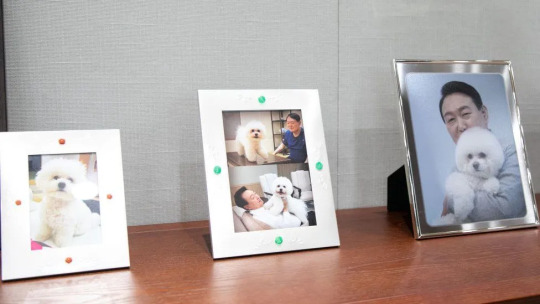
The slaughter and sale of dogs for their meat is to become illegal in South Korea after MPs backed a new law. The legislation, set to come into force by 2027, aims to end the centuries-old practice of humans eating dog meat.
2. February - Greece legalises same-sex marriage

Greece has become the first Christian Orthodox-majority country to legalise same-sex marriage. Same-sex couples will now also be legally allowed to adopt children after Thursday's 176-76 vote in parliament. Prime Minister Kyriakos Mitsotakis said the new law would "boldly abolish a serious inequality".
3. March - Global child deaths reach historic low in 2022 – UN report

The number of children who died before their fifth birthday has reached a historic low, dropping to 4.9 million in 2022. The report reveals that more children are surviving today than ever before, with the global under-5 mortality rate declining by 51 per cent since 2000.
4. April - Restoring sight is possible now with optogenetics
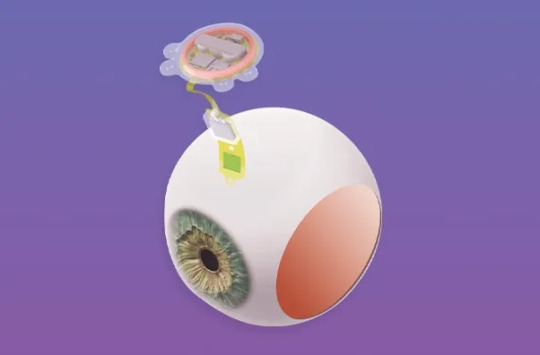
Max Hodak's startup, Science, is developing gene therapy solutions to restore vision for individuals with macular degeneration and similar conditions. The Science Eye utilizes optogenetics, injecting opsins into the eye to enhance light sensitivity in retinal cells. Clinical trials and advancements in optogenetics are showing promising results, with the potential to significantly improve vision for those affected by retinal diseases.
5. May - Vaccine breakthrough means no more chasing strains

Scientists at UC Riverside have demonstrated a new, RNA-based vaccine strategy that is effective against any strain of a virus and can be used safely even by babies or the immunocompromised.
6. June - Bill Gates-backed startup creates Lego-like brick that can store air pollution for centuries

The Washington Post detailed a "deceptively simple" procedure by Graphyte to store a ton of CO2 for around $100 a ton, a number long considered a milestone for affordably removing carbon dioxide from the air. Direct air capture technologies used in the United States and Iceland cost $600 to $1,200 per ton, per the Post.
7. July - Stem cell therapy cures man with type 2 diabetes

A 59-year-old man had been suffering from diabetes for 25 years, needing more and more insulin every day to avoid slipping into a diabetic coma and was at risk of death. But then Chinese researchers cured his disease for the first time in the world. The patient received a cell transplant in 2021 and has not taken any medication since 2022.
8. August - Chinese drones will fly trash out of Everest slopes
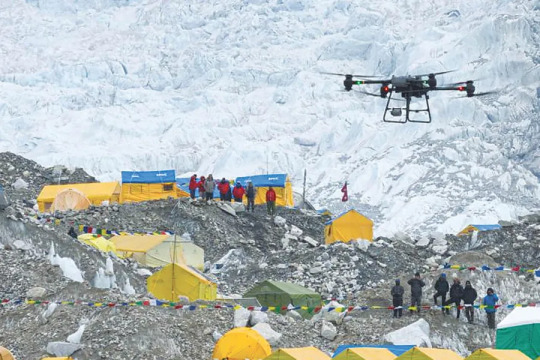
Come autumn, Nepal will deploy heavy lifter drones to transport garbage from the 6,812-metre tall Ama Dablam, south of Everest. This will be the first commercial work an unmanned aerial vehicle does in Nepal’s high-altitude zone.
9. November - Tokyo to make day care free to boost birth rate

Tokyo plans to make day care free for all preschool children starting in September, the city governor has announced as part of efforts to boost Japan's low birth rate.
10. October - FTC Rule Banning Fake Product Reviews Takes Effect With Stiff Penalties
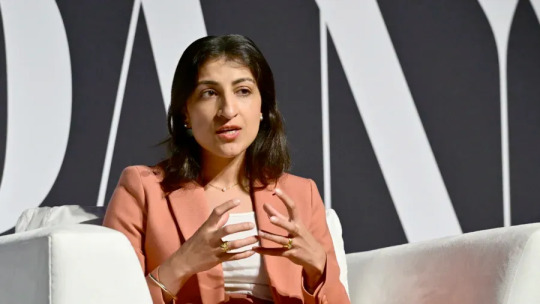
Federal Trade Commission (FTC) Chair Lina Khan announced on Oct. 21 that the agency’s prohibition on fake online reviews was taking effect, imposing fines as high as $50,000 for violations. Khan encouraged followers to report the proscribed practices at reportfraud.ftc.gov.
11. November - Bumblebee population increases 116 times over in 'remarkable' Scotland rewilding project

The bumblebee population has made an impressive comeback in a developed area by increasing to 116 times what it was two years ago thanks to a nature restoration group.
12. December - Spain to enshrine gay marriage and abortion rights into its constitution so 'they cannot be undone in the future'
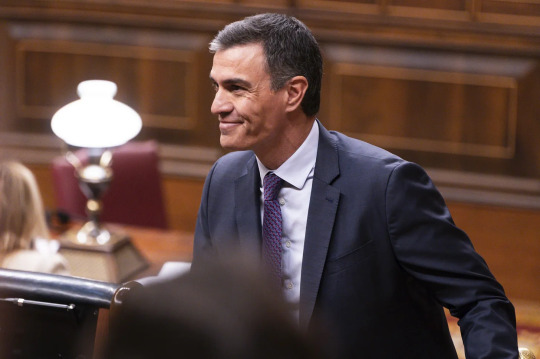
The left-wing PSOE leader made the announcement at an event marking the 46th anniversary of the Spanish Magna Carta.
“We believe that these are rights that we must protect in the Constitution so that no one can touch them in the future,” Sanchez said in a statement in parliament on Friday.
----------
That's it for last year :)
This newsletter will always be free. If you liked this post you can support me with a small kofi donation here:
Buy me a coffee ❤️
Also don’t forget to share this post with your friends.
461 notes
·
View notes
Note
consider: first year UC-berkeley iwaizumi hajime who doesn't know what to do during Thanksgiving Break. it's too much of a hassle and expensive, he reasons, to fly all the way home or to argentina for that short of a break. that time spent flying could be spent studying, not to mention the money. and all of that time spent home will likely still be spent hunched over his laptop and notes, clacking away at his final essays, and decidedly not with his family.
but he also doesn't want to stay in his cramped dorm room all alone. all of his newly-made friends and his dormmate are going home for thanksgiving. but him? he's already elected against flying, and that's pretty much his only option unless he wants to somehow uber all the way to argentina (bad idea).
his roommate then proposes to him: "why don't you just spend thanksgiving with me? we're real nice people, me and my family. we'll even leave ya alone if you wanna study, and we won't make ya eat anything if ya don't want it. it'll just give you a warm place to stay!"
and, well, his roommate is nice. he's heard glimpses of his conversations with his siblings and parents over the phone, and the stories he tells makes his family out to be... funny people, at the very least. and iwaizumi really doesn't want to stay in his dorm.
so. he says, "okay." and his roommate gives him this bright grin that both reassures iwaizumi and sends an inexplicable bone-chilling shiver down his spine. he gets his reasoning later, when his roommate sends him his flight ticket to alabama.
queue an incredibly rural southern thanksgiving with more cousins than iwaizumi can feasibly count to, constant noise and broken windows from all the little ones running around, old geezers talking politics while drinking beer and watching football, three different kinds of casseroles, and a turkey trot the morning of thanksgiving that he had NO prior warning of until his roommate is shaking him awake at five in the morning, talking about a 5k run. and those finals he wanted to study for? those essays he wanted to write? yeah, he doesn't get any time for that. instead, he's playing twister and Wii Sports bowling with both the younger cousins and the drunk adult cousins.
oikawa spares him no sympathy and laughs at him every single day of Thanksgiving Break.
i dont come from a place that celebrates thanksgiving with all the bells and whistles and football like the US does so i dont really know what kind of hell this would be but I know for SURE Japan doesnt have thanksgiving. Iwaizumi would have his roommate be like "hey i dont want you to be alone, wanna come to Alabama for thanksgiving?" and Iwa would be like "what the fuck is thanksgiving and what the fuck is Alabama" and then later he's on the phone with Oikawa and whispering so nobody can overhear him like "i dont KNOW whats happening they fed me about four metric tons of food last night and now they're teaching me how to play american football. no its not like volleyball. the big one shoulder checked me to the ground and I think I broke a rib. send help and send it fast please."
32 notes
·
View notes
Text
Mobile Suit Gundam: Chronological Watch Order for the Universal Century Timeline
UC 0001
Laplace incident – the Universal Century is declared, and Laplace, the Prime Minister’s residence, is destroyed by terrorists (First few minutes of Mobile Suit Gundam Unicorn (2010) Episode 1: Day of the Unicorn)
UC 0068
Mobile Suit Gundam The Origin (2015-2018) Episode 1
UC 0071
Mobile Suit Gundam The Origin (2015-2018) Episode 2
UC 0074
Mobile Suit Gundam The Origin (2015-2018) Episode 3 first half
UC 0076
Mobile Suit Gundam The Origin (2015-2018) Episode 3 second half
UC 0077
Mobile Suit Gundam The Origin (2015-2018) Episode 4 first half
UC 0078
Mobile Suit Gundam The Origin (2015-2018) Episode 4 third quarter
UC 0079 (the One Year War):
Mobile Suit Gundam The Origin (2015-2018) Episode 4 ending, Episode 5 (January 3rd up until January 15th 0079 UC).
Mobile Suit Gundam MS IGLOO: The Hidden One Year War (2004) Episode 1: Vanishing Serpent of Loum, runs from 4th to 17th January 0079UC.
Mobile Suit Gundam The Origin (2015-2018) Episode 6 (The Battle of Loum, January 15th-16th 0079; later events in the epilogue scattered throughout the first half of the year).
Mobile Suit Gundam MS IGLOO 2: The Gravity Front Episodes (2008) Episode 1: Take Out That Angel of Death!, runs from 26th to 27th April 0079UC.
Mobile Suit Gundam MS IGLOO: The Hidden One Year War (2004) Episode 2: Howls Stained in Dusk, runs from 29th April to 11th May 0079UC.
Mobile Suit Gundam MS IGLOO 2: The Gravity Front Episodes (2008) Episode 2: Kings of the Jungle, Roll Out!, runs from 21st to 26th July 0079UC.
Mobile Suit Gundam (1979) Episodes 1-15, starts September 18th 0079UC.
Mobile Suit Gundam: Cucuruz Doan’s Island (a movie adaptation of Episode 15), around about late October 0079UC. This is set in the Mobile Suit Gundam: The Origin timeline, and thus the White Base has already visited Jaburo and all members are officially part of the Earth Federation Forces. The Guntank is replaced by a second Guncannon, Sleggar is present, and Cucuruz Doan's Island is relocated to the Canary Islands rather than Japan, although the event still precedes Operation Odessa.
Mobile Suit Gundam (1979) Episodes 16-25 (up to early November 0079UC)
Mobile Suit Gundam 08th MS Team Episodes 1-11 (October 6th 0079UC up to around 15th November 0079. Starts after 0079 Episode 10 (Garma's death), and finishes sometime after the battle of Odessa during the Zeon Asian Ground Forces retreat)
Mobile Suit Gundam: Requiem for Vengeance (2024), runs from November 6th until around about the end of that week, shortly after Operation Odessa and the evacuation of the Zeon Eastern European and Asian Ground Forces. The timeline is a little sketchy as Yuri Kellerne appears in both this and 08th MS Team, but dies in the latter, but the series definitely ends by at most two days after 8th to 9th November and Operation Odessa in Episode 25 of Mobile Suit Gundam (1979).
Mobile Suit Gundam MS IGLOO 2: The Gravity Front Episodes (2008) Episode 3: Odessa, Storm of Steel!, runs from 8th to 9th November 0079UC, concurrently with Operation Odessa in Episode 25 of Mobile Suit Gundam (1979).
Mobile Suit Gundam MS IGLOO: The Hidden One Year War (2004) Episode 3: Dance of the Orbital Ghosts, runs from 24th October to 11th November 0079UC.
Mobile Suit Gundam (1979) Episodes 25-35 occur from around November of 0079UC up until the start of December, although there aren't many exact dates for when exactly in the year each episode takes place, although The Battle of Solomon in Episode 35 takes place on 24th December 0079 UC).
Mobile Suit Gundam MS IGLOO: Apocalypse 0079 (2006) Episode 1: In the Skies of Jaburo I Saw the Sea, happens from 3rd to 7th December 0079UC, sometime after 0079 Episode 30.
Gundam 0080 War in The Pocket (1989) runs from around December 9th 0079UC up until around 12th to 25th December 0079UC.
Mobile Suit Gundam MS IGLOO: Apocalypse 0079 (2006) Episode 2: Cross the Path of Light, happens from 28th to 30th December 0079UC.
Final few episodes (around 36/37 until 43) of Mobile Suit Gundam (1979) definitively happen on December 30th and 31st 0079UC, as this is when the Battle of A Bao Qu occurs in canon.
Peace treaty with Zeon signed on 1st January 0080UC.
Mobile Suit Gundam MS IGLOO: Apocalypse 0079 (2006) Episode 3: Spirits Returning to the Cries of Thunder, happens from 31st December 0079UC until 1st January 0080UC.
UC 0080
Mobile Suit Gundam 08th MS Team Episode 12 (unspecified number of months after the end of the One Year War)
UC 0083
Mobile Suit Gundam 0083: Stardust Memory (1991-1992)
UC 0087
Mobile Suit Zeta Gundam (1985-1986)
The Gryps Conflict/Gryps War
UC 0088
Mobile Suit Gundam ZZ (1986-1987)
The First Neo-Zeon war
UC 0093
Mobile Suit Gundam: Char's Counterattack (1988)
The Second Neo-Zeon war
UC 0096
Mobile Suit Gundam Unicorn (2010-2014)
Laplace incident - occurs from around April 7th 0096UC til May 4th 0096UC
UC 0097
Mobile Suit Gundam Narrative (2018)
UC 0100
The Principality of Zeon is officially dissolved and reabsorbed back into the Earth Federation
UC 0105
Mobile Suit Gundam Hathaway (2020)
UC 120
Mobile Suit Gundam F90 (1990)
UC 0123
Mobile Suit Gundam F91 (1991)
UC 149
Zanscare Empire Declared, Zanscare War Commences
UC 0153
Mobile Suit Victory Gundam (1993-1994)
End of the Zanscare War and all key members of the imperial core
#mobile suit gundam#gundam#mobile suit zeta gundam#mobile suit zz gundam#mobile suit gundam: the origin#08th MS team#mobile suit gundam the 08th ms team#0083 stardust memory#0080 war in the pocket#requiem for vengeance#watch order#universal century
127 notes
·
View notes
Text
Seiko UC-2000 (1984) Wrist Information System






UC-2000 aka Wrist Information System Cal. UW01-0010
The UC-2000 is a classic 'nerd watch' with a gray bezel and stainless steel band, part of the UC-2000 Series Wrist Information System. Like the Data-2000, it pairs with a pocket-sized beige UC-2100 keyboard. Two variants exist: the UK01-0020 (61 keys) and UK01-0010 (62 keys, with a Kanji toggle for Japan).
The UW01 module stores 2,000 characters and supports time, date, stopwatch, alarm, and hourly chime functions. While not waterproof, it is Y2K-compliant.
One of the few watches to display seconds, date, and day simultaneously, it features a large dot matrix display that spells out the full day name.
source: oldcrap.org
7 notes
·
View notes
Note
Re: Noah’s college poll, here’s my vote. He should go to a school that’s not RSU but should plan (and get his college involved in organizing) a ‘study abroad’ semester at RSU. RSU would still get a boost by developing their study abroad/exchange student connections. And perhaps more importantly: Noah “studying abroad” in the Ask would be objectively hilarious?
AHAHAHA this was sent back before I published the story about his final college choice but this is SUPER FUNNY and 100% something I want to do. Santa Cruz is notoriously pretty laid back about students controlling their own education and it would be highly amusing if Noah decided to do a study abroad semester at Royal Shivadh University, but since he's the first ever student to do so, he has to kind of build the program as he's driving it -- and then, because Noah's a relatively charismatic and well-liked guy, a bunch of Santa Cruz students follow in his footsteps.
Which results in Royal Shivadh University having a kind of sister-school relationship to UC Santa Cruz, and suddenly every semester there's a handful of weird Welsh-accented, extremely mischievous, extremely dry Shivadh students rolling up in Santa Cruz for school, getting summer jobs on the Boardwalk, enthusiastically roadtripping to San Francisco for Pride....
My undergrad alma mater had (and still has) a very strong relationship with a school in Japan, to the point where we actually had a dormitory building dedicated to hosting Japanese students studying with us (it was mixed American freshmen and Japanese exchange, but it was geared towards making sure the Japanese students had a welcoming space that they felt ownership over). They'd arrive in spring, take the spring semester, spend the summer tooling around America, come back for fall semester, and then head back to Japan. They were GREAT fun -- super enthused to learn about America, loved chatting because it helped improve their English, and always really interesting people to hang out with.
Anyway, great idea, gonna reblog this to @shivadh so I can save it for later :D
88 notes
·
View notes
Text
Mrs. Moon demanded that all UC paid staff resign by October 1st.
News about the Unification Church of Japan Hak Ja Han doesn’t want to pay her staff, but instead use that money to fund her newest temple.
For the past two years donations have been almost zero in Japan. In the midst of a serious financial crisis with no donations from Japan, Mrs Moon is still pouring everything into the Cheonwon Palace at Cheongpyeong. She sold real estate and borrowed from financial institutions.
All church money is being pulled into her temple.
It’s being said that every time Mrs Moon tours the temple to check on the building progress she finds more ways to spend money either in furniture, more elaborate decorations or upgrading tech.
Then there is this Japanese leader who is receiving revelations from Sun Myung Moon in the spiritual world. With passionate yelling he tells members that Moon is a hundred percent supporting Mrs. Moon, and the light from the new temple will transform the evil. This leader is known in Japan for creating a team and a teaching that would help members file for bankruptcy, believing that bankruptcy was a divine law.
In the end Mrs. Moon is running out of money and probably losing membership because of her own greed.
Also her closest two aides, one of which is Mrs. Won Ju McDevitt, are under investigation by the police for tax evasion and embezzlement.
___________________________________
Unification Church President Hak Ja Han issued an emergency directive, “Submit resignation letters en masse!”
통일교 한학자 총재 긴급 지시, “일괄 사직서 내라!”
統一教会の韓鶴子総裁緊急指示「一括辞表を出せ!」
Hak-Ja Han kicked out three of her sons and became the sinless object of worship in the movement founded by Sun Myung Moon
$42million of Donations Gambled Away by Hak Ja Han and Unification Church Leaders in Las Vegas
#unification church#sun myung moon#hak ja han#cult#family federation for world peace and unification#UC of Japan#palace
2 notes
·
View notes
Text

The moving Gundam in Yokohama, Japan
#photography#original photography#my photography#my photos#gundam#mobile suit gundam#mecha#moving gundam#gundam rx78#gunam universal centry#travel#travel photography#japan#japan travel#japan photos#gundam uc#rx78#msg#photographers on tumblr#alts.photography
17 notes
·
View notes
Text
★ Main Story | Act 13 - Budding Spring | Chapter 23 - International Minister of Arts and Culture

Kazunari: Ah, the livestream started!
Muku: Is Citron-sama really going to walk the red carpet?
Kazunari: All I’m seeing is overseas celebs so far~.
Kumon: I’m getting kinda excited!
Misumi: There’s Citron~!
Muku: Waah, he’s so dignified and cool…!
Tenma: He really does look like royalty like this.
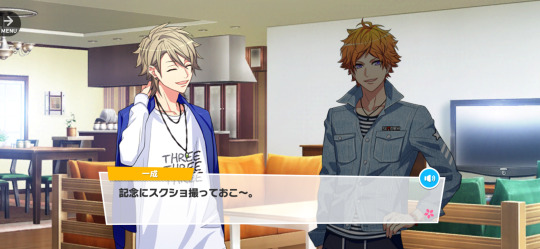
Kazunari: I’ll snap a commemorative screenshot~.
Taichi: Is the interview in English? It’s crazy that Citron’s speaking without an interpreter!
Guy: This is a good opportunity to showcase the Kingdom of Zahra to notable figures in the culture and entertainment fields. It is most effective to communicate with those people in their own language.
Guy: Citronia has acquired foreign language skills to a certain degree for diplomatic purposes.
Banri: Even so, he’s completely different from the usual Citron.
Banri: Can switchin’ to a different language really make that much of a difference?
Guy: In his position, you must have a good outward appearance to a certain degree.
Guy: However, when he speaks Japanese, he is able to somewhat let his inner personality out more.
Banri: Yeah, I think he’s lettin’ it out a lil’ too much…
Tenma: I’m kind of surprised that he’s been able to keep it in at all.
· • —– ٠ ✤ ٠ —– • ·
Citron: 《As the people of Zahra have become increasingly more interested in them, we would like to invite many excellent theatrical and musical performances from overseas to the Kingdom of Zahra.》
Citron: 《I myself belong to a Japanese theater company called MANKAI Company, which has performed overseas in the Kingdom of Zahra.》
Citron: 《Based on that experience, I believe that we can be of great help in terms of support for overseas companies.》
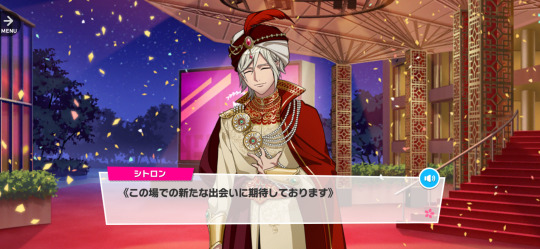
Citron: 《We hope to have many new encounters through this.》
*Applause*
Arts Festival Participant A: 《I have not yet had the experience of visiting your country. I have always hoped to have an opportunity like this someday.》
Citron: 《We look forward to your visit. We have many theater fans among our people, and they will certainly give you a very warm welcome.》
Arts Festival Participant B: 《I have heard much of your success, Prince Citronia. My impression of the Kingdom of Zahra being a more open nation has strengthened thanks to you.》
Citron: 《A little wanderlust can be very useful sometimes.》
Arts Festival Participant A: 《Hahaha. Right, I will be starting a new project to combine theater with the latest in AI technology and--.》
· • —– ٠ ✤ ٠ —– • ·
Citron: …Phew.
Citron: (I’m almost through with the greetings.)
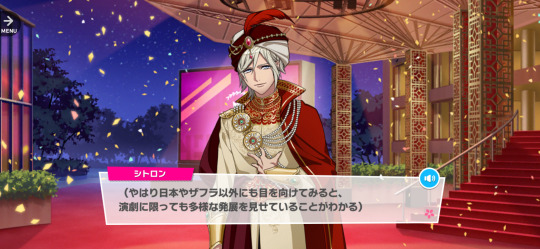
Citron: (After all, if we look beyond Japan and Zahra, we can see that even if we just limit our scope to focus on theater, there is still a diverse range of development all around.)
Citron: (It is stimulating to actively go to places like these.)
Citron: (A whole new door, huh… That reminds me, I wonder if everyone in Spring Troupe watched the broadcast.)
· • —– ٠ ✤ ٠ —– • ·
TorORo has entered the chat.
Saku: He said MANKAI Company!
tsuzuru: It’s pretty amazing to hear your name mentioned at an international arts festival
Curry: citron’s here
tsuzuru: I can’t even begin to tell you how many times I’ve read “TorORo” and wondered who that is
taruchi: skill issue
UC: Aren’t you in the middle of the arts festival right now?
TorORo: i amn on a rake!
Curry: break?
taruchi: the gap’s insane

tsuzuru: That’s our Citron-san
Saku: But it’s kinda a relief!
tsuzuru: It’s like you were a whole different person during the stream
UC: There was a lot of excitement in the company LIME chat too. They were all watching from the lounge.
TorORo: evenb thouvgh we’re aparnt, it is likeb we arbe in rhe same confessional
taruchi: confessional lmfaooo
[ ⇠ Previous Part ] • [ Next Part ⇢ ]
#a3!#a3! translation#sakuya sakuma#masumi usui#tsuzuru minagi#itaru chigasaki#citron#chikage utsuki#// love the image of citron being in the middle of this huge arts festival thing and pulling out his phone to check out the discord chat
25 notes
·
View notes
Text
College Chronicles

Since the deadline to make a decision is nigh, my brother is finally actually touring of some of the schools he's been accepted to.
San Jose State (SJSU) is the current front runner. He needs to get a 3 on the AP Calculus exam to be officially in, although the admissions counselor said there was a work-around there if he didn't. I think it's a test they administer through the university? One of his best friends has also committed to SJSU and said if my brother goes he'd like to room with him. My dad is being a total jackass about this. "It's too close to home." OK? Then you shouldn't have allowed him to apply there! And seriously? We're going to punish the kid because he happened to grow up in an area where there are a ton of great opportunities because you've decided he "needs" to go far away? Shut up.
Chico State (CSCU) is out but my brother said if you could move the campus slightly closer to a city he'd definitely consider it seriously. Totally fair. It's a cute, affordable college town but Sacramento is 1.5 hours away on a good day. I'm glad he's weighing the schools and considering he has to live there.
Long Beach is old and rundown and felt depressing, according to him lol. Fullerton had a nice campus and people were smiling and seemed happy but he finds the 97% commuter aspect off-putting. He also liked the campus at Cal Poly Pomona and said the chemical engineering program sounds fantastic but it's basically Chico but further south (remote, not much going on in the area). But, he hasn't officially eliminated it.
SF State is also an option but is even closer to my parents' house than SJSU (my stepmom drives past it on her way to work most days) and so again, my dad is being a pill about it. My brother doesn't seem terribly excited about it, anyway, other than he knows the area and spends time in the city anyway so it's comfortable.
He hasn't visited Sonoma or Northridge. He turned down UC Santa Cruz's waitlist spot. At one point UC Davis was also in the mix (waitlisted) but he didn't love it when he visited and told me he had it at the top of his list because it's a UC and "everyone told me to be into it."
I told him if he wants to talk through his thoughts/concerns I'd be happy to help him make some pro/con lists or figure out his non-negotiables or just listen to him vent and he said he knows and loves me (omg) and he's going to sleep on it and talk to his girlfriend (who also got into SJSU and liked it, FYI) and he may call me to talk later. At this point I may offer to be there when he tells his parents his decision if for no other reason than to whip something at my dad's head if he expresses anything other than enthusiastic support.
@pelicanhypeman and I are pretty sure it's going to be SJSU. My dad thinks I support this because it's 10 minutes from my house and uhhhh... if the kid wanted to go to school in Japan I'd support him! What is there to be gained by shitting on his decision, especially if it's not an inherently harmful one? He'll pull away from us out of hurt, not out of finding independence. I don't want that kind of relationship with him.
Now I need to figure out what to get him as a graduation present (I still owe him a trip from 8ther grade graduation in 2020) and order the bullhorn for the ceremony.
23 notes
·
View notes
Text
Reverend Moon Rises Above Ailing Businesses (1999)
By Don Kirk, International Herald Tribune Feb. 5, 1999
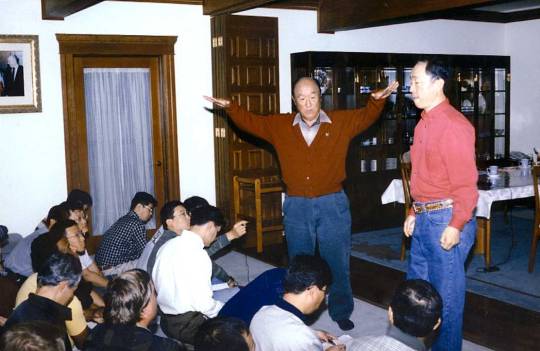
▲ Pictured: Reverend Sun Myung Moon addresses the Third International Ocean Challenge in Kodiak Alaska, September 9 through October 18, 1998. Peter Kim translates. (source: tparents.org)
The Reverend Sun Myung Moon, leader of the Unification Church, opened a "world culture and sports festival" Thursday night asking participants: "What happens to us when we die?" His temporal business empire in South Korea, meanwhile, was asking: How do we repay debts approaching $2 billion
Weakness emerged within the Tong Il group, a conglomerate whose name means "unification," as Mr. Moon toured South Korea over the past week drumming up support for his church and his companies.
"The Tong Il companies suffer from bad management," said Huh Man Jo, who is monitoring the restructuring efforts of Korea's chaebol, or conglomerates, for the government's newly formed financial supervisory service. "They relied too much on church donations. It was a kind of moral hazard."
Mr. Huh said the debts of the group's 16 companies exceed 2 trillion won ($1.7 billion).
Its four leading companies, which manufacture products ranging from ginseng tea to tank guns, were all bankrupt awaiting reorganization under court supervision, he said.
Mr. Moon appeared oblivious to his earthly problems Thursday night. Alexander Haig, a former secretary of state and White House chief of staff during Richard Nixon's presidency, introduced him as "a leading force for inter-religious dialogue and understanding between peoples of all backgrounds."
The closest Mr. Moon came to mentioning the companies that he founded in the 1960s as the basis for his worldwide ministry was when he told a rapt audience that "Earth is but a speck of dust."
The spirit world that people enter after death transcends time and space, Mr. Moon said, speaking in Korean after a six-course banquet. Interpreters translated into seven languages for an audience that included former Third World heads of state and ambassadors. "There are no factories there to produce food," Mr. Moon said. "There are no automobile factories. There is nothing like that."
In the real world, the Tong Il group's flagship Tong Il Heavy Industries Co., founded in 1962, has suffered the most of any of the companies in the group.
The factory, which produces motor vehicle transmissions, has had to lay off 40 percent of its or conglomerates, for the government.
2,000 workers as a result of sagging car sales in South Korea, said Seo Pyong Kyu, a manager in the group's financial planning department.
"There is a cash flow deficit," Mr. Seo said. "Production is very low."
Church donations, a traditional source of funding in hard times, "have helped but are very much limited," said Mr. Seo. "Maybe we can expect the Reverend Moon to help, but it is not certain."
Mr. Moon, who maintains a headquarters in New York but has been spending much of his time on a vast farm project in Brazil, focused throughout his speaking tour of South Korea on the theme of "family ethics and world peace," the topic of a three-day series of seminars sponsored by the church. The festival is scheduled to wind up Sunday with a mass wedding in which 40,000 couples will exchange vows in Seoul's Olympic Stadium in a ceremony broadcast worldwide by cable. As in previous mass weddings, Mr. Moon himself has personally selected many of the marriage partners flying in from throughout the world, from submitted photographs and brief biographies.
Periodically, however, the realities of South Korea's economic crisis intruded upon his national tour.
At stops on the way, workers who had lost their jobs staged demonstrations accusing Mr. Moon's lieutenants of illegally dismissing them without pay. During an appearance in Pusan, South Korea's largest port city, workers from Tong Il Oil Heavy Industries briefly threatened violence.
Mr. Moon did not talk directly to the workers, leaving negotiations to his lieutenants. The response from management was not sympathetic.
"They want to get money from the company," said Ahn Ho Yeol, vice president in charge of the Korean branch of its Youth Federation for World Peace. "We cannot make money. They did not work. We did not offer them money."
Mr. Moon opened his remarks Thursday night by calling for "the realization of a culture of love, a global culture of heart."
Pak Bo Hee, who co-founded The Washington Times with Mr. Moon, goes to North Korea on Monday to negotiate the rights to open a tourist service to the North and to join the celebration of the 57th birthday of the North Korean leader Kim Jong Il on Feb. 16.
Tong Il Heavy Industries, meanwhile, survives on military contracts that it first obtained during the rule of Park Chung Hee, a former general who ruled South Korea for 18 years until his assassination in 1979. "We make rifles and cannon for tanks," said a company official. "The contract is going on."
Source: NY Times
Related articles and notes
Two articles below shed light on the relationship between Moon and Alexander Haig, who in the article above called Moon “ a leading force for inter-religious dialogue and understanding between peoples of all backgrounds."
Excerpted from article: taken from a Facts and Details article n Sun Myung Moon
“After Moon’s release from a US prison after serving 13 months he was still welcomed by the great and good. At various times he met or received support from the British prime ministers Margaret Thatcher and Edward Heath, ex-presidents Gerald Ford and George Bush Sr, Canadian ex-premier Brian Mulroney, US senators Strom Thurmond, Jesse Helms, William Fulbright and Orrin Hatch, Reagan’s defence secretary Caspar Weinberger, the former Nato chief general Alexander Haig, former US education secretary William Bennett, Boston University president John Silber, Christian Coalition ex-chief Ralph Reed, and the rightwing Christian leader the Rev Jerry Falwell.
Excerpted from a paper: The Unificationist Funerary Tradition by Lukas Pokorny describes the seunghwa’s role and evolution in UC/FFWPU history
“[“Honoring a Legacy of Peace”] was held on 18 March 2010 in the New York UN headquarters, 37 “involving” the spirits of Alexander Haig (1924–2010), a general and Secretary of State under Ronald Reagan (1911–2004; p. 1981–1989); 38 former South Korean president and Nobel Peace Prize Laureate Kim Tae-jung 김대중/金大中 (1924–2009; p. 1998–2003); Hédi Annabi (1943–2010), the head of the UN Stabilisation Mission in Haiti, and some one-hundred of his staff, who died when the Port-au-Prince UN Headquarters collapsed during the Haiti Earthquake; former Costa Rican president Rodrigo Carazo Odio (1926–2009; p. 1978–82) called by Mun a Peace President (p’yŏnghwa’ŭi taet’ongnyŏng 평화의 대통령) for his role in the establishment of the University for Peace; former Indonesian president Abdurrahman Wahid (1940–2009; p. 1999–2001); former Icelandic prime minister Steingrímur Hermannsson (1928–2010), who hosted the 1986 Reykjavík Summit between Reagan and Mikhail Gorbachev (b. 1931); the Senegalese head of the Tijaniyyah Sufi order Hassan Cissé 1945–2008); and the Indian politician and diplomat Laxmi Mall Singhvi (1931–2007), whom Mun called an Ambassador of Reconciliation and Peace (hwahae’wa p’yŏnghwa’ŭi taesa 화해와 평화의 대사). On 13 April 2010, the first of a corresponding series of events held in South Korea—the World Peace Leaders Memorial Unification Seunghwa Festival Commemoration Meeting (segye p’yŏnghwa chidoja ch’umo t’ongil sŭnghwa ch’ukche kinyŏm taehoe 세계평화지도자추모통일승화축제기념대회/世界平和指導者追慕統一昇華祝祭紀念大會)—was staged in Seoul. 39 There the Seunghwa Blessing was once again given to Haig, Kim, Annabi, Carazo Odio, and Wahid. Additional receivers were Douglas MacArthur (1880–1964); the former South Korean minister of labour Cho Ch’ŏl-gwŏn 조철권/趙澈權 (1929–2007); the former Nepalese prime minister Girija Prasad Koirala (1924–2010); the naval diver Han Chu-ho 한주호/韓主浩 (1958–2010), who died on a rescue mission for the Ch’ŏnan corvette which was scuppered by a North Korean torpedo in March 2010; 40 and, surprisingly, also the Unificationist elder Kim Wŏn-p’il 김원필/金元弼 (1928–2010), who had already obtained a World Seunghwa Ceremony a few days prior.
Excerpted from article: The below excerpt is from a Forbes article ‘Reaching for the Stars’ by Toni Fitzgerald that reveals that Paul Rogers, a professional Moonie, was able to make profit with Moon-associated businesses during the South Korean financial crisis. Rogers is known to have had strong business relationships with notable UC leaders, such as both Kwak and Pak.
In the late 1990s, the darkest days of South Korea’s financial crisis, operators such as Paul Rogers of Lehman Brothers were parachuting in to pick through the bargains. But amid all the moneylosing units being shed by the country’s conglomerates, what caught his eye was something that wasn’t for sale: a vacant 12-acre lot. It was in the heart of Yeouido, the island in the Han River that serves as Seoul’s financial and broadcasting district.
Owned by Reverend Moon Song-myung’s Unification Church Foundation, the giant lot had sat empty for three decades. Best known internationally for its cultish practices and its members, called Moonies, the church is also a business empire with interests ranging from media properties to North Korean industrial ventures. And like other Korean conglomerates, it needed money. “Investment banks were making a quick buck from acquiring and flipping distressed assets,” says Rogers, then Lehman’s head of structured finance for Asia. “I saw a much bigger opportunity: developing whole city blocks and making an impact on Asian cities which are sorely in need of iconic but commercially successful projects.”
Excerpt from article: Excerpted from Joongang Daily's 2010 article on Kook Jin Moon, 'Business Engine Of A Global Faith' by Kim Hyung-eun
Chairman [Kook Jin Moon] Moon, in a recent interview with Forbes, said he has high hopes for TIC, and that he is proud the company produces axles for armored vehicles. TIC was established by merging several subsidiaries of Tongil Heavy Industries, which previously supplied hardware for the Korean armed forces.
Other units include building management company Seilo, helicopter operator Tongil Air Systems and agricultural company Pyeongnong.
Through these entities, Tongil Group finances about 20 religious and educational institutions, including the Sun Moon University, Sunhwa Arts High School, music group the Little Angels and others.
But Tongil Group is not the only fiefdom in the Unification Church's business empire. It's not to be confused with Unification Church International, which is run by Kook-jin's older brother Hyun-jin and whose major businesses include the The Washington Times and True World Foods in the U.S. as well as Marriott hotels and the Central City complex in Korea.
Video: A 1 minute clip from the Japanese news of a Japanese UC service in 1998 where a church leader begged and guilted members to make a donation. This was a year after the South Korean financial crash and UC families in Japan were forced to make a $16,000 donation. This was during Japan’s decade(s) of economic stagnation.
youtube
#Japan#south korea#unification church#moonies#ffwpu#family federation for world peace and unification#tongil group#Tong Il Heavy Industrie#tongil heavy industries#businesses#uc businesses#1999#economy#financial crisis#Park Chung Hee#chung hee park#dprk#north korea#democratic republic of korea#alexander haig
0 notes
Text
Cincinnati’s Kit Kapp Mapped Uncharted Waters, Popularized Indigenous Art & Was Forgotten By His Hometown
When Amor Smith “Kit” Kapp Jr. died in Florida at the age of 86 in 2013, not a single Cincinnati news outlet carried an obituary or, in fact, any mention at all. The oversight was remarkable since Kit Kapp had been featured in more than 60 Cincinnati news stories between the 1940s and the 1970s.
Almost every day of Kit Kapp’s long life was worthy of a news story somewhere. He was born in 1926 to Loretta and Amor Smith Kapp Sr. in Walnut Hills. His father was a lumber dealer and the marriage was rocky. Loretta sued for divorce twice. The second time, it took. Throughout high school and college, Kit lived with his father.
As a youngster, Kit was bedridden with scarlet fever. He told his father he wanted to build a boat, so Amor Kapp Sr. drove down to the Ohio River and took photos of a towboat. Dad told the Cincinnati Post [18 December 1955]:
“I put those pictures on a drafting board and we started to build. That darn boat took nine months to make, but Kit still has it. It has 144 miniature lights that work and a miniature paddle wheel.”
Inspired by the towboat project, Kit launched his own business, the American Model Company, to sell model boat kits to hobbyists while still a student at Anderson High School.
While living in Mount Washington, Kit walked down to Coney Island and pestered the concessionaires into letting him exercise their ponies and horses. He was just 15 when he signed up to work on a dude ranch in Oklahoma. The next summer found him at a “real” ranch in Arizona. Diving into the cowboy culture, Kit became fascinated by the guns of the Old West and managed to become, at age 17, the youngest person licensed as a firearms dealer by the U.S. government. He boasted that he owned more Smith & Wesson sidearms than any collector in the country.
Kit enrolled at the University of Cincinnati in 1944 but was almost immediately drafted into the Army. He served as a paratrooper in an airborne division based in Japan during the post-war occupation. While overseas, he discovered two new passions: mountain climbing and the Ainu, an indigenous people found in the far northern reaches of the Japanese archipelago. Typically, Kit located every book published on the Ainu – 15 in total, all in Japanese – and hired Japanese students to translate them. He amassed a significant collection of Ainu artifacts and set about connecting Japanese scholars at Hokkaido Imperial University with anthropology faculty at UC.
Returning to UC after his discharge as a sergeant, Kit convinced the Lambda Chi Alpha fraternity to climb Mount Whitney, the highest mountain in the contiguous United States. But, when the time came for the expedition to depart, Kit found himself alone. He told the Cincinnati Post [24 June 1947]:
“A couple of my fraternity brothers were going along, too, but they apparently thought it was just a lot of talk and made other plans for the summer. So I’m going alone.”
On his way west, Kit climbed Signal Peak in Utah and El Capitan in Yosemite National Park. He summited Mount Whitney, hauling a 63-pound pack, and then climbed nearby Mount Muir, not as tall but treacherously steep. According to the Post [29 December 1952]:
“He reached the peak, then gazed down on 1200 feet of sheer precipice. The descent was more a rock-grasping operation than anything else. Kit’s foot slipped and he went tumbling. The whole slope seemed to slide with him. In the best mountain-climbing manner, he stuck out his arms and spread his legs to provide the best brakeage possible.”
Kit ended up with a twisted right leg, a heel pried from one boot, and a determination to find another mountain to climb. Instead, he bought a cheap automobile and drove it through Central America. He blamed it on Burton Holmes.
Almost forgotten today, Burton Holmes was something like a Depression-era globe-trotting Rick Steves. Holmes filmed exotic locales and traveled the country narrating his movies in very popular and remunerative lectures. In April 1946, Holmes presented a filmed tour of Mexico at UC’s Wilson Auditorium, extolling the fine automotive route along the new Pan-American Highway, but warning his audience not to attempt driving further into Central America, because it couldn’t be done.
That sounded like a dare to Kit Kapp. Boasting, as he put it, a bankroll “just thick enough to see through,” Kapp bought a 1929 Model-A Ford for $64 in 1948 and drove it all the way to Costa Rica. As a friend later wrote:
“Claiming to be a journalism student, Kit succeeded in meeting and interviewing the presidents of both Nicaragua and Guatemala during his trip. His car survived the journey back to the US, despite suffering 18 bullet holes passing through a small revolution in Nicaragua.”
Kit changed 51 flat tires and somehow made it back to Cincinnati without the benefit of second gear just in time to enroll for his junior year at UC’s College of Business Administration. Soon after graduation in 1950, Kit sold his model boat company and his firearm collection and bought a 41-foot ketch he named Fairwinds and sailed for the Caribbean. The original Fairwinds was wrecked in a gale, so Kit acquired a 50-foot “bugeye” ketch and christened it Fairwinds II.

With St. Thomas in the U.S. Virgin Islands as a base, Kit launched a charter company, hauling tourists around the area, eventually wandering farther and farther afield. Along the way, he met and married his first wife, the former Lois Fatzinger of Palmerton, Pennsylvania. After a decade running charters, that marriage dissolved, and Kit decided that he would rather go exploring than stick to a charter’s set schedule. He told the Post [18 December 1965]:
“I decided to get out of the high rent district. Running a charter boat is like running a sea-going taxi.”
Instead, he offered expeditions to crew members who paid him for the privilege of exploring rarely visited islands and coasts.
“I make plans ahead of time and if anyone wants to go along they pay $200 for two weeks. They work, but not hard. They help clean up, aid in survey work, help carry equipment on the island beaches. We work about five hours a day, then we swim or loaf.”
Many of those expeditions were sponsored officially by the Explorer’s Club of New York. That organization designated Kit as a fellow of the society. Among his regular customers was physicist J. Robert Oppenheimer. Kit’s travels took him into previously uncharted waters near the coast of Panama, and it was here that he generated his most culturally impactful discovery.
Kit’s efforts to survey the San Blas Islands off the north coast of Panama led to a lifelong interest in the Guna tribespeople who lived there. The Guna (or Kuna) produced unique fabric designs known as mola, vibrantly colored and intricately layered fabric pieces worn by the Guna women. The process involved in creating molas is often described as “reverse appliqué,” in which pieces of fabric are cut away to reveal layers underneath. Kit was among the first outsiders to appreciate and study these dynamic artworks and to bring them to the attention of scholars worldwide. His self-published 1972 monograph, “Mola art from the San Blas Islands” remains the definitive introduction to the art form.

During dozens of voyages around the San Blas Islands, Kit’s quest for reliable charts inspired him to seek out, collect, study and sell antique maps. Some of the maps he found were quite valuable. One sold at auction for $34,000. By 1967, Kit had accumulated a substantial inventory, enough to mount an exhibition in Jamaica. During the opening reception for that exhibit, Kit met his second wife, Valerie, born on the Isle of Wight, who helped coordinate his buying and selling trips to England and the Continent.
As Kit and Valerie shared their discoveries in Guna art, their travels brought them to Cincinnati, where they coordinated a landmark exhibition of molas and ritual Guna statuary at the Studio San Guiseppe at the College of Mount St. Joseph in 1972. Enquirer [13 February 1972] art critic Owen Findsen was impressed:
“Leaving the ethnology to Captain Kapp, the Mola can be seen as a pure art form. One must be taken by the intense coloring of many of them which can set up visual vibrations to compete with the Op artists. And the designs are clever in the same way that the pseudo-primitive art of Paul Klee is clever, by its directness and its innocence.”
The colors and patterns of mola fabric art filtered into popular fashions throughout the 1970s. Women around the world wore clothing and carried handbags replicating Guna mola designs, usually with no awareness of the original source.
As a dealer in antique maps, Kit built a reputation as a discerning connoisseur and befriended several other influential collectors. British map dealer Simon Hunter was one such colleague. He recalled:
“Kit was a very astute buyer, but he was also a most entertaining character whose good humor and traveler’s tales made it impossible to resent the large discounts he invariably managed to obtain on his many purchases.”
All the while he was buying and selling maps, Kit earned acclaim as a formidable scholar who also had the expertise to create his own maps. His many academic publications include analyses of maps, inventories of known charts and monographs on native peoples. Worldcat lists more than 40 publications under his name, with at least a dozen publications being maps of previously unfathomed waters.
After 25 years devoted to collecting and selling maps, Kit and Valerie decided that their business, no matter how successful, was detracting from the time available for exploring their beloved Caribbean. They pivoted toward selling by consignment through other dealers, rather than issuing their own catalogs. The sheer volume of their collections necessitated buying a house with a large garage on land, and they settled in Nokomis, Florida.
Over the years, significant honors accrued. In addition to the prestigious Explorers’ Club, Kit was awarded a permanent card for the British Museum Reading Room and memberships in the Royal Geographical Society, the Adventurers' Club of New York, the Archaeological Institute of America and the American Geographical Society.
After Kit’s death in 2013, his widow discovered more than 60 cartons of uncatalogued Guna art that he had packed away since the early 1970s. While itemizing that substantial collection, she discovered a room covered by a false wall in the garage with even more fabrics and statuary. Much of this new inventory is now available through various auction houses.

16 notes
·
View notes
Text



These arrived in the mail from Japan today. Going to frame them, they are so pretty. (◍•ᴗ•◍)❤
I ordered more, mostly UC cards, but they are still stuck in customs.
86 notes
·
View notes